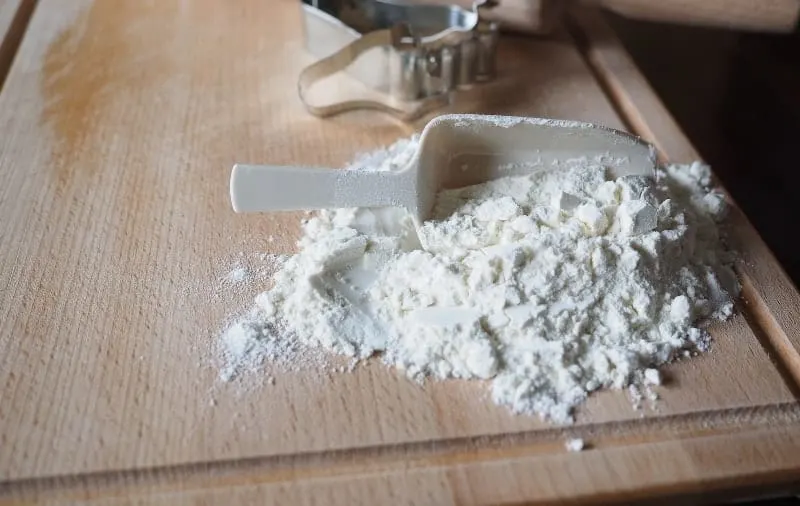With so many different kinds of flours on the shelves, it’s difficult to know which one to pick. Some are store-branded and cheap whilst other branded ones may be expensive.
Some people may say “flour is just flour” and get on with their day like they haven’t just strongly offended a baker, but the truth is that every flour is going to be different. Even flours from the same brand may be slightly different.
The brand of flour you use does not matter, but the composition of it does. Different flours will vary in protein content depending on where they’re milled and what grains are used. Find a flour that works well for you and stick with it.
The brand might not matter, but the type of flour you use definitely does. You want to find high-quality flour with the right protein content for the best results.
If you’re baking anything you still want quality flour. Don’t settle for flour just because of the price or brand or you might be left with inferior results.
Instead of thinking specifically about branding or price, look into the flour protein content and see if it’s in line with what you’re baking.
A good brand of flour will have quality control to maintain the level of protein in each batch.
Is There A Difference In Flour Brands?
You know that the brand of flour you use isn’t what’s important, but there are some key differences between flours and it’s important to know what they are.
The main difference between brands of flour is their protein content. Not all flour has consistent protein content due to different grains. One brand of all-purpose flour may have 11% protein whilst another may have 9%, so it’s important to always check the packaging.
Some brands bleach their flour to lighten it since a lot of consumers are put off by flour that isn’t quite white enough. It would be wise to avoid this bleached flour due to its slightly different PH and potential health issues. Keep in mind that a lot of countries have banned bleaching of flour, so it’s not a problem for everyone.
Other than the protein content of flour and the grains the flour is milled from, there’s not a significant difference between brands. Just find something that you enjoy working with and think tastes good rather than worrying about what brand to use.
Is There A Difference Between Cheap And Expensive Flour?
Most people’s general perspective of things is that a higher price correlates to a higher quality. This makes complete sense and is the case for most things, however, that doesn’t mean that it applies to flour as well.
For the most part, there’s not a huge difference between cheap and expensive flour. You might pay extra depending on what store it’s from, the type of packaging, if it’s unbleached or organic, and the branding on it, but the flour is the same.
Spending more money on flour may make sense in some cases, but you can also end up spending more money on a product that’s extremely similar to a cheaper flour.
Don’t take this the wrong way though. More expensive flour can definitely be better than something that’s cheaper, but it’s down to you to figure out which is best for your purposes.
The initial things you want to take into consideration is the protein content of the flour and whether it is bleached or not. The protein content you want depends on what you’re making and it’s always wise to go for unbleached flour.
It would be smart to experiment with different kinds of flours so you can see which one you prefer the most rather than just buying an expensive one because you’ll think it’s better.
Flour Is Different Everywhere
Wheat crops grow very easily, so a lot of flour is milled from places all over the world, but it’s all different.
The type of flour you get depends on the grain it’s milled from, but wheat flour will also vary depending on the climate, growing conditions, and type of wheat grown.
For this reason, the wheat grown in one part of the US can be completely different from another grown across the country.
There are also multiple different varieties of wheat that all yield different results when milled, so the grain used to mill flour could be completely different even if both flours come from the same place.
Hard or soft and red or white wheat can all be used to make flour.
No matter where you go in the world, you’ll find different kinds of flour.
To Sum Everything Up…
The branding or pricing of a bag of flour doesn’t necessarily matter because it may not always be what type of flour you’re after.
When buying a bag of flour, you want to look for one that’s around your desired protein content and that’s completely unbleached.
By using a flour that’s specific to your needs, you’ll notice results that are far superior and tasty to what you’d get from other flour that’s just randomly picked off the shelves.
Before you go to buy your next batch of flour, I challenge you to do some research into flour protein content and find what works best for the type of food you’ll be making.
When you’ve done this research, you’ll be able to look closely into each flour and pick one that is more appropriate for what you’re making.

